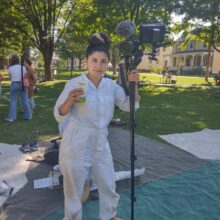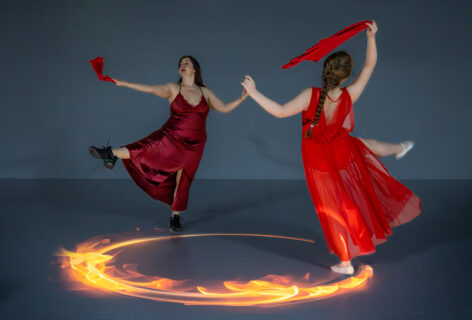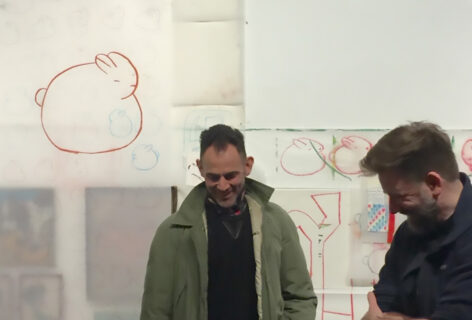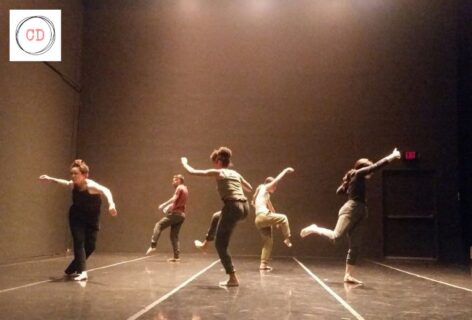Download a PDF of this writing
A year and a few months ago, I set out to find what sort of retirement plan is available for dance. However this question is really a topical surface; a lid on a huge can of worms, knotted and torn amongst each other.
Such a question is large and can be answered in so many ways; regardless of the outcomes the answer can always be argued because there is no one way to retire. Each body has its own constitution with its own needs for survival. To retire is personal. However, in knowing this I continued to go forth with my research on what sort of retirement plan is available in dance, in hope to find something I had not expected to find when I first set out, an answer or possible answers to my question.
While thinking about retirement, I read My Friends by French writer, Emmanuel Bove. The book, published shortly after World War I in 1922, is a lens into the fictional life of Victor Bâton. Bâton is a veteran of war. The first time I tried reading the book, I couldn’t get into it. Though short in length, the structure of the sentences gave me the feeling the book was long and arduous. On the second attempt to read, I succeeded in making it to the end. Bâton tells his story in first person and as the reader I traveled with him through his daily routine; him telling his story as it happened.
Reading the book was torture because Bâton is a very lonely man. He is not only lonely, but in sharing his story he made me feel lonely. The story is told in first person with many sentences beginning with “I”. As the reader, I let myself believe that Bâton was the actual writer of his story and in doing so I experienced Bâton as being caught up in his action to tell and describe his experience in a room, street, hallway, restaurant, a lady’s presence. In becoming so absorbed in the detail that surrounded him, he lost his ability to communicate in a socially acceptable way with the people outside of and surrounding him throughout his day-to-day routine. It’s not only that his way was unaccepted by society, but that his way of communicating kept him from getting the things he needed and maybe even wanted out of life.
The story is difficult.
Bâton is stingy, not only with others but with himself. He is fearful and observant of the tiny details of life that usually don’t have the time to be noticed. Bâton is so willing to trust when the one he is relating to matches his criteria, and so quick to disown when the character makes one move out of Bâton’s assumption on how a friend should behave. The others in the story are also caught up in their inherited / programmed ways of interacting. This way of being for them makes them unable to connect with a person who is operating in the way Bâton does and with this inability to connect, a large gap remains between Bâton and the other people.
Because of Bâton’s use of language, his presence is so pronounced he feels like some representation of self, while every person outside of him is other. In the example of My Friends I feel that “self” and “other” are two different developments of consciousness and in My Friends these two consciousnesses are unable to communicate or find a meeting point between each other.

The conscious Victor Bâton employs in this story for the most part, begins all of his sentences with “I”, while Bâton’s counter, uses the “I” as a jumping off point, reaching for the “I”s and objects around themselves in order to generate conversation and keep conversation from getting too close and self-centered.
Last fall, when I was suppose to be preparing for my show at The Chocolate Factory, I was stuck between the conscious and unconscious mind. I wanted to make a piece of live performance where my unconscious mind was the driving force of the piece, but felt torn and terrified to do so because I felt that there was nothing valuable or sustainable about the characteristics of the unconscious mind. When making from the unconscious mind I feel there is no monetary supplement for its efforts.
When I make, between my brain and myself, I’m either developing from the conscious or unconscious mind. Consciousness can be debated in so many directions, but I experience my states and my states’ relationship with the world as either coming from one of two parts: the conscious or unconscious.
Before making something— up until this point—I have told myself at the beginning of a process—for reasons inline with whatever objective I have subjectively drawn up for the building of a work—that I will construct the piece from either the conscious or the unconscious mind. It is not possible to actually only use one side of one’s conscious, even if the there is a conscious attempt to activate one side in hoping the other will remain doormat, but there are ways of manipulating consciousness in order to make more use of one than the other. From my experience, when I choose one or the other, the one I choose stays on the front two burners while the other one sits on the back, and only on one of the two back burners.
Using feelings to discuss theory feels unscientific, but my experiences and their outcomes are real. When I make from the unconscious mind it takes a lot of energy, a lot of up keep. In order to fully activate my unconscious mind I have to consciously disconnect from a linear relationship to the world. In doing so my physical appearance becomes more of a need and prominent, more of a necessity to survive. In order to maintain my unconscious mind I feel a pressure to sustain and constantly strive to heighten my physical ability. Though I may experience movement in order to maintain physical ability, something about this application of movement keeps me held in place. In this place of unconscious activation, I see the world propelling forward while I stay put, holding onto a specific moment derived by society, which I have inherited as an assumption of authentic feeling.
When I am swimming in the unconscious mind my face is beautiful in that Marilyn Monroe sort of way. Not that I have any resemblance to Monroe, but what I am trying to say is when living in the unconscious mind, one’s face becomes imperative and iconic. The face of the unconscious mind is not worn out, wrinkled or tired. The face of the unconscious mind represents youth and naïveté and can easily be transformed from live to object. For example, a breathing face or body can be captured by a photo, blown up into the form of a poster and then thrown onto most street corners. This action of photographing / painting a face and then hanging for public display, acts as a reminder to the conscious mind of a place the conscious mind has once been, and has now moved on from. In this relationship the conscious’ use of the unconscious mind uses death as a way of motivating life into the future.
When I am swimming in the unconscious mind, I feel anger towards those who employ an active—and healthy?—conscious mind. Though the conscious mind gazes in the direction and sometimes stands near the unconscious mind, it feels that the conscious mind’s connection to the linear and narrative mechanics of society holds more value than the unconscious mind’s connection, which I have mentioned from my experience as being not linear. Consequently, the dynamic played out between the two consciousnesses feels like the conscious mind is superior to the unconscious mind. It feels like the conscious mind assumes itself as being more capable or the only one to be able to see and activate motion into life because of the conscious mind’s attachment to language produces a narrative and/or past narrative, which consequently creates for a sense, or assumed sense, of known.
Also this feeling of superiority derived from the conscious mind, results in never fully trusting the decisions made by the unconscious mind, unless the outcome of the unconscious’ mind is beautiful and glamorous enough to represent a specific memory in culture’s (America’s?) history. Characteristics of beauty and glamour are determined by the conscious mind and with this decision-making the conscious mind decides if and how much value chosen memories hold. This selection process by the conscious mind not only represents time but also contributes to an economy’s sustainability, production rate, and profit.
In the relationship where the conscious and unconscious mind remain near each other, but not in conversation with each other, it feels as if the conscious mind is dependent on the unconscious mind to hold onto and embody certain events in history in order to support and give flow to the economy, which the conscious mind benefits from. This sort of relationship leads to a top-heavy policy for shifting money through and with this sort of relationship, how can either side of consciousness benefit? This set-up produces a gap remaining between the two. What happens inside of the gap and where and how do people operate within it?
I don’t know the answer to this question, but in realizing I wanted to be working from the unconscious mind I began to panic and wonder what sort of retirement plan is available for dance.

Why was I asking such a question? It seems like a ridiculous question to ask, but given my thoughts on the exchange and imbalance that occurs when more value, trust and/or responsibility is given to one side of consciousness versus the other, my asking this question came from my fear in trusting that the unconscious mind holds any value.
There is no retirement plan for dance just as there is no retirement plan for painting or music or literature. Whether an artist consciously knows it or not, entering and committing to a form of art for application, is in consequence to apply one’s mind and body to the risk of not subscribing to enforced laws or rules for maintaining function. I do believe that one thing art-making does, is to consciously pluck one’s self from the laws governing society as a way of generating an outside lens to analyze what society is contracting itself to and as a repercussion, experiencing.
Can laws, determined by government, support what could potentially challenge a law’s intention?
What do I mean by government?
My ears hear the word government and my brain generates an image of a block of orange cheddar cheese from Wisconsin. I see the block of cheese and I see it sitting in the front row of a display case containing cold cuts, dairy and meat.
I see the cheese and I cannot smell it because it is encased like a relic in a museum preserving some specific history. I see this encased cheese as having no arms, legs, heart, blood, colon, mouth—no parts of a human anatomy. And yet the cheese is there, as something for me to consume in order to receive the nutrients I need to survive?
I see the cheese and I imagine myself punching it and I imagine in this punch the cheese would bruise me before I would be able to bruise it.
Why would I want to bruise the cheese and why would the cheese bruise me if I made contact with it? Have I embodied government as something that would hurt me and not help me? And in feeling this, do I wish to hurt it as sort of defense mechanism to my ego?
I don’t have any answers to these questions because I don’t feel as if I am equipped to do so—I mean, I just drew government as a block of orange cheddar cheese instead of the system that it is, but that’s the thing—I don’t know what government is or what its purpose is in my life. Or how or why I am supposed to be relating or having a relationship with it.
I’m writing all of this because a year ago from this past September I became hysterical about what sort of retirement plan is available in dance. And with all of the time that has passed and all of the thought I have collected on this question my body has generated for itself—I feel nothing but hatred towards myself in asking this question because to ask this question out loud feels too revealing. In being public with asking this question, it feels like I reveal who I am and I don’t want to reveal myself. I don’t want my audience, whether I’m consciously onstage or off, to know whom I am.
In addition, to ask what sort of retirement plan is available in dance feels like I am revealing my placement within the system of class. To ask about retirement would suggest a potential need for such a thing and who needs retirement? What class of people both financially and physically needs retirement? I suppose any class could argue needing retirement, but when I hear the word, I imagine working class bodies. Bodies whom have experienced minimal compensation for their contracted commitment and physical efforts to work for the system; a body’s enslaved-ness to systemized labor.
To me, to perform in another person’s choreography feels working class. Or my experience of it has been such. As a performer you work for minimal, if any, financial compensation and there is not only a mandatory physical participation in order to do the work, but a mandatory up-keep of the body in order to maintain the body that can do the work of a performer; a maintenance that feeds the unconscious mind.
The choreographer on the other hand receives the praise for the final product and even though the compensation that is received in the position of the choreographer maybe equal if not less to what the performers in the choreographer’s work earns—the choreographer is what is remembered for the work performed. Dance or the making of proscenium-based (whether the actual architecture is present or not) dance is a tiered system with the performers at the bottom and the choreographer’s at the top. Does middle even exist in this sort of arrangement?
Any class reveals a certain use of language and when I hear the working class language I hear something that registers as much spicy and fragrant, as it does flamboyant. A language that runs over the line of need for function and into the pool of excessiveness. To me this working class language doesn’t know how much it doesn’t need to share, as well as, how much it doesn’t need in the form of material in order to survive. This unrealized ignorance of how to use language in the most efficient and effective way possible eats away at the lives operating the working class. In effect, using language in this excessive manner reveals just how much money is in one’s pocket and it doesn’t compare or compete with any of the tiers above it. As people we wear our value and as an artist I experience this sort of costuming of value as moving beyond my body and into the manifestation of the work I produce.
To be a part of the working class, you are strong enough to support the base of the triangle, but the monetary reward for the foundation / base-like quality of yourself is not substantial enough to move around and have access to the opportunity and information within the tiers that are dependent on the design and ability of yourself.
Why is it so painful—why is it so difficult to not have money? And why does not having money feel like a trap?
Money is energy and people and the institutions people create are dependent on the shift of energy. When shifts happen through people or institutions, it is an exchange of giving and receiving. People live to exchange, right? This is what human’s do on the most animalistic level—we exchange. We exchange between each other and when we do life happens, metaphysically and literally.
An answer for what sort of retirement plan is available for dance is too personal of a question to have only one answer. And though dance is as personal as coming directly from the body, dance is too porous to be defined by a singular definition or singular mean for survival. It occurs to me to subscribe dance, my dance, to a retirement plan birthed by the block of cheese, feels like I would be subscribing to a subscription that would limit and keep me in place like the legless cheddar cheese. How can one function and grow when stagnation is imposed?
I don’t know!
And I don’t know what sort of retirement is available in dance because I don’t believe there is or can be one. Or I do not believe there can be one with the way I have understood content (dance) and structure (government as a block of cheese) to be relating to each other.
If I’ve learned anything from this year of pondering, provoked by a seed of fear, it is that value resides not only in the conscious mind, but in the unconscious mind too. Whether consciously or unconsciously isolating these parts or allowing for conversation between the two, it is the process of doing so and the discourse these conversations produce that will give any mind and body, the foundation and knowledge needed to age and retire.
CE says thank you to luciana achugar + Chase Granoff, June Ekman, Tara Lorenzen, Yves Musard and Jen Rosenblit for the discussions and emails, sharing with her their thoughts on retirement in dance.





